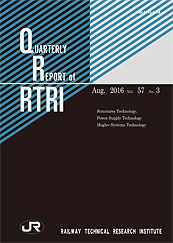Volume 57, Issue 3
Displaying 1-12 of 12 articles from this issue
- |<
- <
- 1
- >
- >|
PERSPECTIVES
-
2016 Volume 57 Issue 3 Pages 165-170
Published: August 01, 2016
Released on J-STAGE: October 18, 2016
Download PDF (3166K) -
2016 Volume 57 Issue 3 Pages 171-174
Published: August 01, 2016
Released on J-STAGE: October 18, 2016
Download PDF (1795K) -
2016 Volume 57 Issue 3 Pages 175-178
Published: August 01, 2016
Released on J-STAGE: October 18, 2016
Download PDF (1409K)
PAPERS
-
2016 Volume 57 Issue 3 Pages 179-182
Published: August 01, 2016
Released on J-STAGE: October 18, 2016
Download PDF (2332K) -
2016 Volume 57 Issue 3 Pages 183-190
Published: August 01, 2016
Released on J-STAGE: October 18, 2016
Download PDF (3145K) -
2016 Volume 57 Issue 3 Pages 191-198
Published: August 01, 2016
Released on J-STAGE: October 18, 2016
Download PDF (2669K) -
2016 Volume 57 Issue 3 Pages 199-206
Published: August 01, 2016
Released on J-STAGE: October 18, 2016
Download PDF (2594K) -
2016 Volume 57 Issue 3 Pages 207-212
Published: August 01, 2016
Released on J-STAGE: October 18, 2016
Download PDF (3509K) -
2016 Volume 57 Issue 3 Pages 213-220
Published: August 01, 2016
Released on J-STAGE: October 18, 2016
Download PDF (1734K) -
2016 Volume 57 Issue 3 Pages 221-227
Published: August 01, 2016
Released on J-STAGE: October 18, 2016
Download PDF (3153K) -
2016 Volume 57 Issue 3 Pages 228-233
Published: August 01, 2016
Released on J-STAGE: October 18, 2016
Download PDF (2816K) -
2016 Volume 57 Issue 3 Pages 234-239
Published: August 01, 2016
Released on J-STAGE: October 18, 2016
Download PDF (3605K)
- |<
- <
- 1
- >
- >|
